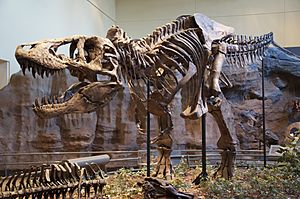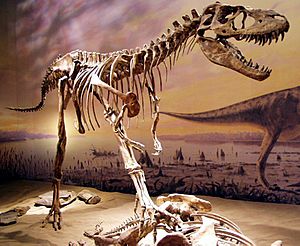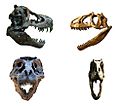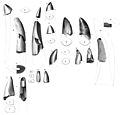Tyrannosaurids facts for kids
Quick facts for kids Tyrannosaurids |
|
|---|---|
 |
|
| Tyrannosaurus skeletal mount, Carnegie Museum of Natural History | |
 |
|
| Gorgosaurus skeletal mount, Royal Tyrrell Museum of Palaeontology | |
| Scientific classification |
|
| Kingdom: | Animalia |
| Phylum: | Chordata |
| Clade: | Dinosauria |
| Clade: | Saurischia |
| Clade: | Theropoda |
| Superfamily: | †Tyrannosauroidea |
| Clade: | †Pantyrannosauria |
| Clade: | †Eutyrannosauria |
| Family: | †Tyrannosauridae Osborn, 1906 |
| Type species | |
| †Tyrannosaurus rex Osborn, 1905
|
|
| Subgroups | |
|
|
| Synonyms | |
|
|
Tyrannosauridae is a group of amazing meat-eating dinosaurs called theropods. These dinosaurs lived during the Upper Cretaceous period, which was the last part of the dinosaur age. They roamed the Earth about 88 to 65 million years ago.
You might know their most famous member, Tyrannosaurus rex! But there were many other types of tyrannosaurids. Their fossils have been found only in North America and Asia.
Contents
What Are Tyrannosaurids?
Tyrannosaurids were a family of large, two-legged dinosaurs. They were known for their powerful jaws and sharp teeth. Most of them were top predators in their ecosystems. This means they were at the very top of the food chain!
Key Features of Tyrannosaurids
These dinosaurs had some special features that made them unique:
- Big Heads and Strong Jaws: They had huge skulls with very strong jaws. Their teeth were like sharp knives, perfect for tearing meat.
- Small Arms: One of the most famous features is their tiny, two-fingered front arms. Scientists are still trying to figure out exactly what these small arms were used for!
- Powerful Legs: Their back legs were very strong and muscular. This allowed them to run fast and chase their prey.
- Binocular Vision: Many tyrannosaurids, like T. rex, had eyes that faced forward. This gave them excellent binocular vision, which helped them judge distances when hunting.
Where Did They Live?
Tyrannosaurids lived in different parts of the world. Most of them were found in what is now North America and Asia. They lived in various environments, from forests to floodplains.
North American Tyrannosaurids
Some well-known tyrannosaurids from North America include:
- Tyrannosaurus rex: The most famous of all, found in western North America.
- Albertosaurus: A slightly smaller but still powerful predator from Canada.
- Gorgosaurus: Another large tyrannosaurid, also found in Canada.
- Daspletosaurus: A strong and heavily built tyrannosaurid from North America.
Asian Tyrannosaurids
Asia was also home to some impressive tyrannosaurids:
- Tarbosaurus: Very similar to T. rex, found in Mongolia.
- Alioramus: A more lightly built tyrannosaurid with a unique long snout, also from Mongolia.
How Did They Hunt?
Tyrannosaurids were skilled hunters. Their strong legs helped them run down prey. Their powerful jaws and teeth could crush bones. Scientists believe they were both active hunters and scavengers. This means they hunted live animals but also ate animals that were already dead.
What Did They Eat?
As theropods, tyrannosaurids were carnivores, meaning they ate meat. They likely preyed on large plant-eating dinosaurs that lived in their areas. For example, T. rex might have hunted dinosaurs like Triceratops and Edmontosaurus.
Discovering Tyrannosaurids
Fossils of tyrannosaurids have been found for many years. The first tyrannosaurid remains were teeth found in the 1850s. These early discoveries helped scientists understand that huge meat-eating dinosaurs once roamed the Earth.
Famous Discoveries
- The first Tyrannosaurus rex fossils were found in the early 1900s.
- Many complete skeletons of Albertosaurus and Gorgosaurus have been found. These discoveries help us learn how they lived and hunted.
- The discovery of juvenile tyrannosaurids, like "Jane" (a young T. rex), helps scientists understand how these dinosaurs grew from babies to adults.
Images for kids
-
Tyrannosaurid (T. rex) and allosauroid (Allosaurus fragilis) skulls. Note the forward-facing eye sockets of T. rex.
-
Cast of the skeleton of Jane, a juvenile tyrannosaurid in the Burpee Museum of Natural History in Rockford
-
The eye-sockets of T. rex faced mainly forwards, giving it good binocular vision
-
Skeleton of Daspletosaurus (specimen FMNH PR308) at the Field Museum in Chicago
-
Full size model diorama of a group of Albertosaurus, Royal Tyrrell Museum
See also
 In Spanish: Tiranosáuridos para niños
In Spanish: Tiranosáuridos para niños











